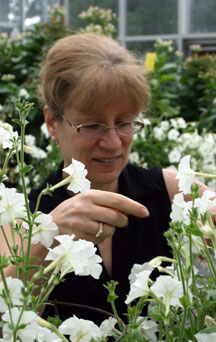Plants use 'unusual' microbial-like pathway to make essential amino acid
January 8, 2014
 |
|
Natalia Dudareva |
WEST LAFAYETTE, Ind. - Purdue University researchers have discovered a microbial-like pathway in plants that produces phenylalanine, an amino acid that is a vital component of proteins in all living organisms.
Plants mainly synthesize phenylalanine through a chain of chemical reactions that converts the organic acid arogenate to phenylalanine. But Purdue researchers demonstrated that plants also use an alternative pathway found in most microorganisms to make phenylalanine from phenylpyruvate.
"Now that we have genetic evidence that this pathway exists in plants, this opens up many exciting possibilities for metabolic engineering," said Natalia Dudareva, distinguished professor of biochemistry. "This alternative pathway provides a whole new avenue to synthesize phenylalanine."
Phenylalanine is an aromatic amino acid that serves as a building block for many compounds essential to plant structure, reproduction, defense and communication. Manipulating the alternative pathway to increase production of phenylalanine could help improve plants' response to pests, Dudareva said.
Phenylalanine is also used to synthesize other compounds such as benzoic acid, a component of cancer-treating drugs.
Humans and animals cannot make phenylalanine, relying on plants to supply the phenylalanine necessary to build proteins. Increasing the phenylalanine levels in plants could yield more nutritional foods, said Heejin Yoo, a biochemistry graduate student and study co-author.
The researchers found that plants use both the arogenate pathway and the alternative pathway to make phenylalanine. But flux through the alternative pathway increases when stress factors limit a plant's ability to use the main pathway. Joshua Widhalm, a postdoctoral fellow in biochemistry and study co-author, likened the pathways to a system of water pipes.
"Imagine two diverging pipes that share an opening," he said. "The main pathway is a pipe with a greater diameter than the alternative pathway. You're always going to have a little bit flowing through the smaller pipe. But if you plug up that main pathway, you're going to see more redirected through the alternative pathway."
When the researchers separately blocked each of the two steps in the arogenate pathway in petunia flowers, phenylalanine levels decreased. But when they blocked both steps simultaneously, phenylalanine production spiked.
"That's when we knew there had to be some other way of synthesizing phenylalanine," Dudareva said.
The researchers were surprised to find that in the alternative pathway phenylpyruvate is converted into phenylalanine by taking a nitrogen group from tyrosine, another essential amino acid.
"It's very unusual that the cell would sacrifice tyrosine to make phenylalanine," Dudareva said. "That may be one reason why this pathway was not discovered earlier."
Enzymes involved in the arogenate pathway are tightly controlled to balance phenylalanine levels, halting the production of phenylalanine if levels are too high. Regulation is less strict in the alternative pathway, which is only limited by the availability of tyrosine.
The more relaxed regulation of the alternative pathway makes it a more promising target for metabolic engineering than the arogenate pathway, Dudareva said.
"When you're working with the arogenate pathway, you have to take its sensitivity to phenylalanine levels into account, which is very tricky," she said. "But in the alternative pathway, you only need to have a source of nitrogen groups to synthesize as much phenylalanine as you want."
While the arogenate pathway occurs in the plastids - organelles that are also the site of photosynthesis - the alternative pathway is located in the cytosol, the fluid that suspends organelles and other particles inside a cell. This is the first indication that the synthesis of aromatic amino acids can occur outside of the plastids, Widhalm said.
"It appears that plant aromatic amino acid metabolism is even more dynamic than we gave it credit for," he said.
The paper is available in Nature Communications at http://www.nature.com/ncomms/2013/131125/ncomms3833/full/ncomms3833.html
Funding for the research was provided by the U.S. Department of Agriculture, the U.S. Department of Energy, the National Science Foundation, and the Gordon and Betty Moore Foundation.
Writer: Natalie van Hoose, 765-496-2050, nvanhoos@purdue.edu
Sources: Natalia Dudareva, 765-494-1325, dudareva@purdue.edu
Joshua R. Widhalm, 765-494-3612, jwidhalm@purdue.edu
Heejin Yoo, 765-494-3612, yoo8@purdue.edu
ABSTRACT
A microbial-like pathway contributes to phenylalanine biosynthesis in plants via a cytosolic tyrosine: phenylpyrunvate aminotransferase
Heejin Yoo 1; Joshua R. Widhalm 1; Yichun Qian 1; Hiroshi Maeda 1, 2; Bruce R. Cooper 3; Amber S. Jannasch 3; Itay Gonda 5; Efraim Lewinsohn 5; David Rhodes 1; Natalia Dudareva 1, 4
1 Department of Horticulture and Landscape Architecture, Purdue University, 625 Agriculture Mall Dr., West Lafayette, IN 47907
2 Current address: Department of Botany, University of Wisconsin-Madison, 430 Lincoln Drive, Madison, WI 53706
3 Bindley Bioscience Center, Metabolite Profiling Facility, Purdue University, West Lafayette, IN 47907
4 Department of Biochemistry, Purdue University, West Lafayette, IN 47907
5 Institute of Plant Sciences, Newe Ya'ar Research Center, Agricultural Research Organization, PO Box 1021, Ramat Yishay 30095, Israel
E-mail: dudareva@purdue.edu
Phenylalanine is a vital component of proteins in all living organisms, and in plants is a precursor for thousands of additional metabolites. Animals are incapable of synthesizing phenylalanine and must primarily obtain it directly or indirectly from plants. While plants can synthesize phenylalanine in plastids through arogenate, the contribution of an alternative pathway via phenylpyruvate, as it occurs in most microbes, has not been demonstrated. Here we establish that plants also utilize the microbial-like phenylpyruvate pathway to produce phenylalanine, and flux through this route is increased when the entry point to the arogenate pathway is limiting. Unexpectedly, we find the plant phenylpyruvate pathway utilizes a cytosolic aminotransferase that links the coordinated catabolism of tyrosine to serve as the amino donor, thus interconnecting the extra-plastidial metabolism of these amino acids. This discovery unlocks another level of complexity in the plant aromatic amino acid regulatory network, unveiling new targets for metabolic engineering.
Ag Communications: (765) 494-2722;
Keith Robinson, robins89@purdue.edu
Agriculture News Page

